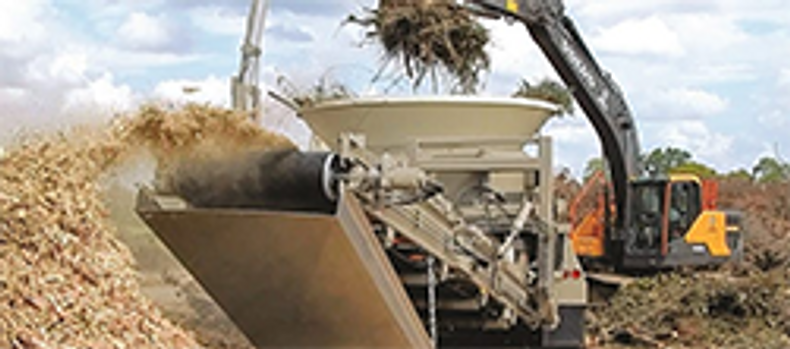Loading Your Grinder, Plan Ahead!
How you plan to load your tub grinder or horizontal grinder will significantly impact your machine selection, production rates and operating costs. Factors such as load height, infeed size, bucket or grapple size, and the operator’s view will all play a role in the success of your operation.
Most operators load grinders with a knuckleboom grapple, excavator, or a loader. Paring your grinder with the right loading equipment can significantly increase production, help reduce risk of contaminants, and increase operator and equipment safety.
Below is a brief overview of factors that should be considered when planning your operation and how you will load your grinder.
- Load Height – Since the load height for horizontal grinders is much lower this section primarily focuses on the loading height of tub grinders. The load height will typically range between 9’ and 12’. If working with a grapple attached to your grinder, or an excavator the load height may not be a big concern. However, if you are using a bucket loader, getting material into the tub may be an issue. Most operators either utilize high-lift (or roll-out buckets) or build dirt ramps near their machines. Dirt ramps work well if you do not plan on moving the grinder often, but some operators will move their grinder too often to build multiple ramps. High-lift buckets can be attached to most loaders and only requires a third valve function, which can be added if your loader is not already equipped with it. High-lift buckets can add 3’ to 5’ of reach to your loader. High-lift buckets are also handy in recycling yards for loading material into screening equipment and trailers. Failure to plan for the load height of your grinder can lead to reduced production and damage to your equipment from attempting to load with inadequate equipment.
- Infeed Size – The size of the infeed for both tub grinders and horizontal grinders will impact production.
Tub Grinders – For tub grinders there are three important infeed dimensions that will determine how the machine is loaded (excluding load height which was previously discussed) as well as production rate.
- 1.Tub Top Diameter – This will determine how big of a target your loader has and will determine what size bucket you can use. Larger tub allows for a larger bucket and fewer loader trips. A larger tub also helps reduce spillage around and the grinder which can become a fire hazard.
- 2.Tub Base Diameter– Nearly all grinders utilize a flange at the top of the tub to increase the top diameter and make the grinder easier to feed. However, it is the base of the tub that will determine how easily material can access the hammermill and the actual production rate. Large flanges create a funnel affect and can cause bridging problems which significantly reduce production rates.
- 3.Tub Depth – The depth of the tub (in connection with the base diameter) will determine how much material you feed. A larger tub depth will allow the operator to fill the tub and let the grinder process material while the operator moves output piles, or prepares additional raw material. Shallow tubs will throw more material and require that the loader closely monitor feed rates to keep up with the grinder’s production.
Horizontal Grinders – For horizontal grinders there are three important infeed dimensions that will determine how the machine is loaded as well as production rate.
- 1.Infeed Width – the width of the infeed, in connection with the width of the hammermill. Wider infeeds make larger targets when loading, and allow you to grind wider material such as whole pallets. Although the wider infeed will improve loading, the hammermill size will determine production rates.
- 2.Infeed Length – When grinding whole trees, a longer infeed allows the operator to place longer trees in the grinder’s infeed deck. This reduces raw material preparation time and helps maximize production rates. When working in more space restricted areas, a longer infeed can make the grinder more difficult to maneuver, however, making the shorter infeed deck preferable in some instances.
- 3.Infeed Height – this relates primarily to the height of the feed roller from the infeed deck. In general a higher infeed will enable a grinder to feed larger diameter material. Infeed height along with the infeed width will determine how much material can access the hammermill at a time and determine production rates of the grinder.
- Feed Capability – I am referring primarily to the speed with which material can be fed into the grinder. This is a factor that I believe is commonly overlooked by operators new to grinding. Factors such as the distance of the grinder from the raw material, the size and type of raw material, and the size of your loading equipment will all play a role in determining the load speed. Keep in mind that when piling finished product on the ground your loader may have to stop loading the machine on a regular basis to move the pile away from the machine thereby reducing true loading rate per hour.

